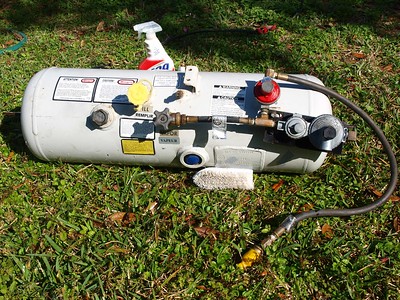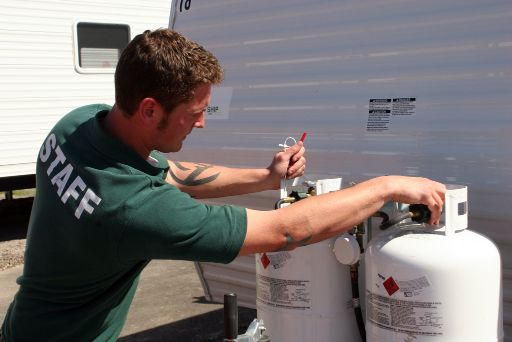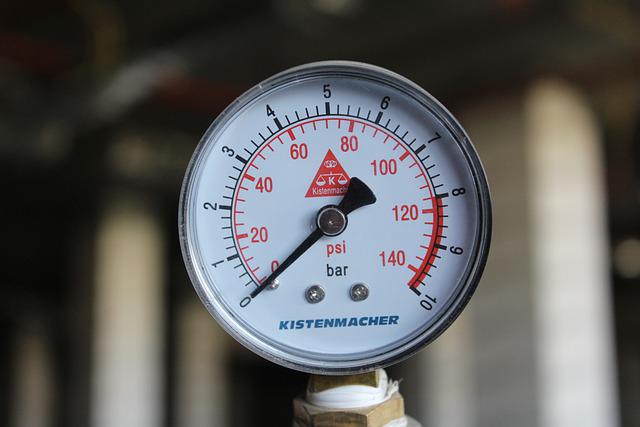One of the most common questions propane users want to know is “why is my propane tank not working?” There are many reasons that can cause a propane tank to not work properly, as well as ways to troubleshoot. We outline some of the most common causes and what you can do about them!

Propane tanks are common in many homes and businesses, helping you cook, heat, and more. They’re super handy, but it’s essential to remember that if something goes wrong with them, it can be dangerous. That’s why you need to spot problems early and fix them right away. Keeping your propane tank in good shape isn’t just about convenience; it’s about keeping you and your surroundings safe.
In this article, we’ll talk about the possible causes of why your propane tank is not working. Read on to learn more…
Symptoms of Malfunctioning Propane Tank
| Symptom | What It Indicates | Potential Risks |
|---|---|---|
| Incomplete Combustion or Yellow Flame | Normally, propane burns with a clean blue flame. If the flame is consistently yellow or orange, it suggests that the propane isn’t burning efficiently. This can be due to a variety of reasons, such as an improper air-to-gas mixture or contaminants in the gas. | Incomplete combustion can produce carbon monoxide, a dangerous, odorless gas. Prolonged exposure can be harmful and even fatal. |
| Reduced Gas Flow or No Gas at All | If your appliances aren’t receiving enough gas or any at all, there might be an issue within the tank system. This could be due to a nearly empty tank, a faulty regulator, blocked hose, or a triggered safety mechanism. | Reduced gas flow can lead to appliances not functioning correctly or shutting down unexpectedly, which can be problematic if you’re relying on them. |
| Unusual Noises from the Tank or Connected Equipment | Hissing, whistling, or banging noises are not typical for propane systems during regular operation. Such sounds can indicate a gas leak, pressure issues, or problems with an appliance. | Aside from potential gas leaks, unusual noises might also suggest that components are worn out or broken, which can lead to more significant malfunctions or safety concerns. |
| Foul Odor Indicating Potential Leaks | Propane in its natural state is odorless. However, an odorant called ethyl mercaptan is added to give it a distinct smell for safety reasons. If you start noticing a strong, skunky, or rotten-egg-like smell, it’s a clear sign of a propane leak. | Gas leaks are hazardous. Not only is there a risk of fire or explosion, but inhaling propane can also be harmful. |
being aware of these symptoms is crucial for anyone using propane. If you observe any of these signs, it’s imperative to act swiftly, prioritize safety, and consult with a professional. Proper maintenance and regular checks can also preempt many of these issues, ensuring a safe and efficient propane system.
Here the the Common Causes
1. The tank is turned off
If the propane tank is not working, the most likely cause is that the tank is turned off. If the tank is turned off, the flow of propane to the appliances will be interrupted and they will not work. To turn on the propane tank, follow these steps:1. Locate the tank control valve. This is usually located near the base of the tank.2. Turn the control valve to the “on” position.3. Check all of your appliances to make sure they are working properly. When the tank is turned on, check the gauge if the tank has sufficient gas.
While this may seem like an obvious solution, it’s often overlooked. Make sure to check if the valve at the top of the tank is in the “on” position before troubleshooting any other issues.
2. Tank pressure is inadequate
It is likely because the tank pressure is inadequate. Propane tanks need to be refilled or replaced when the pressure gets too low. You can check the pressure in your propane tank with a pressure gauge. If the gauge reads below 100 pounds per square inch (PSI), then your tank needs to be refilled or replaced. Please note that the normal pressure is between 100-200 PSI depending on the outside temperature.
There are a few reasons why your propane tank may have low pressure. If you have recently used a lot of propane, such as for cooking or heating, then the tank may need to be refilled. Or, if it is a cold day, the propane in the tank may have condensed, which decreases the pressure. Also, if your propane tank is old, the valves and seals may not be working properly, which can cause leaks and lower pressure. If you think your propane tank may be low on pressure, contact your local propane supplier to have it checked and refilled or replaced.
If you’re experiencing problems with your propane tank, one potential cause is that the tank pressure is inadequate. This can happen for a variety of reasons, including if the tank is low on propane or if there’s a blockage in the line. If you suspect that tank pressure is the issue, the first thing you should do is check the level of propane in the tank. If it’s low, you’ll need to refill it. If there’s a blockage, you’ll need to clear it before the tank will work properly again.
3. The tank’s excess-flow valve in the tank is not working
If the excess-flow valve in the tank is not engaged, the propane tank will not work. This is because the excess-flow valve is designed to shut off the flow of propane if it senses that the flow of propane gas is too high. If the valve is not engaged or shut-off, then propane cannot continue to flow out of the tank.
Make sure that excess flow valve working perfectly every time. The valve has important function in the system – it shuts off the flow of the gas when it detects large leak. Technician should regularly check the system, including this ever important component.
4. Water has gotten into the tank
If liquid or water has gotten into your propane tank, it is possible that the tank is not working properly. This can be a serious problem, as liquid or water can contaminate the propane gas and cause it to be less effective or even dangerous. If you suspect that liquid or water has gotten into your propane tank, you should contact a qualified technician to check the tank and make sure it is safe to use.
5. The regulator is defective
The problem might be because of the defective regulator. A regulator is a critical component of a propane tank, as it controls the flow of gas from the tank to the stove or other appliance. If the regulator is not working properly, the gas will not flow and the appliance will not work.
There are a few things that can cause a regulator to become defective. The most common cause is a build-up of dirt and debris in the diaphragm, which prevents it from opening and closing properly. This can be caused by leave and debris getting into the gas line, or by not properly cleaning the regulator after each use. Another common cause of regulator failure is freezing, which can damage the delicate internal components.
If you suspect that your regulator is defective, you should take it to a qualified technician for repair or replacement. Trying to repair a regulator yourself can be dangerous, as it involves working with potentially explosive gases. Only a qualified technician has the training and experience to safely repair or replace a propane regulator.
6. Damaged O-ring and diaphragm
Another possibility is that the O-ring or diaphragm inside the regulator is damaged, preventing it from sealing properly. Or the pressure relief valve could be stuck in the open position, allowing too much propane to escape. If you suspect that your propane tank’s regulator is not working properly, the first thing you should do is check the O-ring and diaphragm for damage. If they look okay, then try resetting the pressure relief valve. If none of these solutions work, then you will need to replace the regulator.
The O-ring becomes brittle over time. In fact, it is recommended that the regulator should be replaced every three years. When the tank and its regulator are exposed to elements, the recommendation is to replace it every year.
Overlooked Regulator Issues with Your Propane Tank
1. Mismatched Regulators: The Wrong Fit Can Be a Big Problem
a. The Easy Mistake to Make:
You might not think it matters, but using the right regulator for your propane tank is essential. Just because it fits doesn’t mean it’s the right one.
b. The Consequences You Might Face:
Using the wrong regulator can lead to uneven gas flow, reduced efficiency, or even safety hazards. It’s like using the wrong charger for a device; it just doesn’t work properly.
c. Picking the Right Match:
Always ensure you’re using the recommended regulator for your specific tank. If unsure, it’s always a good idea to consult with an expert.
2. Diaphragm Damage: The Silent Performance Killer
a. What’s Going on Inside:
Inside the regulator, there’s a diaphragm that helps control gas flow. Over time, wear and tear or external factors can damage it.
b. The Sneaky Effects:
A damaged diaphragm might not be immediately noticeable, but it can cause inconsistent gas flow or even gas leaks. This means your grill, heater, or other devices might not work as efficiently.
c. Keeping an Eye (or Ear) Out:
If you notice any unusual sounds from the regulator or if your propane-burning devices aren’t working as they should, it might be time to check the regulator’s diaphragm.
When it comes to your propane setup, always ensure you’re using the right regulator and pay attention to its internal health. Overlooking these issues can impact performance and safety. Simple awareness can make a big difference.
Unconventional Causes of Propane Tank Malfunction
1. Propane Composition Issues
a. Understanding Propane Purity:
Did you know that pure propane is actually colorless and odorless? That distinctive smell you associate with propane is added for safety, to help detect leaks. But sometimes, what’s in your tank might not be pure propane.
b. How Impurities Might Sneak Into Your Propane:
During extraction and refining, other gases like butane, propylene, and ethane can mix in with your propane. While your tank is designed for propane, these impurities can change how it burns, its efficiency, and even its safety.
c. Why You Should Care About Impurities:
Using impure propane can lead to irregular burning. You might notice soot build-up on your burners or changes in pressure in your tank. Over time, these impurities can even corrode the inside of your tank and lead to malfunctions.
2. Internal Valve Wear
a. The Hidden Wear Inside Your Tank:
While you might be keeping an eye on the outside of your propane tank, the inside parts are constantly under pressure, leading to wear and tear you can’t see.
b. How This Affects You:
A worn internal valve can cause propane to flow inconsistently. You might experience sudden flares or a drop in pressure when you’re using your equipment. This isn’t just inefficient; it can also be dangerous if you’re not prepared for these changes.
c. What You Can Do About It:
It’s a good idea to have your tank inspected regularly. If you suspect there’s an internal problem, reach out to professionals who can help either repair or replace the affected parts.
What to Do When You Suspect a Problem
If you think there’s an issue with your propane tank or system, it’s essential to act quickly and safely. Here’s what you should do:
- Turn Off Appliances and the Main Valve: Start by shutting down any appliances using propane. Then, turn off the main valve on the tank. This can help prevent any further gas release.
- Ensure Proper Ventilation: Open windows and doors to let fresh air in, especially if you’re indoors. This helps dissipate any gas that may have leaked and reduces the risk of inhalation.
- When to Call a Professional: If you’re unsure about the problem or how to fix it, it’s always best to call in an expert. Don’t wait too long; if you suspect a leak or any significant issue, getting professional help promptly is crucial.
- Avoid DIY Solutions Without Proper Knowledge: While it’s tempting to troubleshoot on your own, some problems require specialized knowledge. Working on a propane system without the right expertise can be risky. Always prioritize safety over a quick fix.
Remember, your safety and the safety of those around you is paramount. When in doubt, always err on the side of caution. To learn more about related OSHA guidelines on propane, see this page.
Taking Care of Your Propane Tank
1. Substandard Repairs: Beware of the Quick Fixes
a. The Temptation of a Quick Solution:
We’ve all been there. Something goes wrong, and the immediate instinct is to opt for the quickest, often cheapest, solution. But when it comes to propane tanks, this approach might cost you more in the long run.
b. The Downside of Cutting Corners:
‘Quick fixes’ might seem to solve the issue initially, but they can often mask a deeper problem or even introduce new ones. For example, using non-compatible parts or improper sealants can lead to leaks or reduced efficiency over time.
c. Why You Should Think Twice:
While it’s frustrating to deal with a malfunctioning propane tank, opting for substandard repairs can compromise your safety and the longevity of your equipment. It’s always better to invest in quality repairs to ensure the issue is properly addressed.
2. The Importance of Regular Check-ups
a. Beyond Visible Issues:
Just because you don’t see or experience any immediate issues doesn’t mean your propane tank is in perfect condition. Like any equipment, wear and tear happen over time, often unnoticed until a significant problem arises.
b. The Benefits of Periodic Professional Assessments:
Having a professional check your propane tank regularly ensures:
- Early detection of potential problems, allowing for timely interventions.
- Verification that all components are in good working order.
- Assurance that your tank operates at maximum efficiency, saving you money in the long run.
- Peace of mind knowing that your tank is safe for use.
c. Setting a Schedule:
It’s advisable to set a routine check-up schedule based on the usage and age of your propane tank. For heavily used tanks or older models, consider more frequent inspections.
Dos and Don’ts You Need to Take Note Of
Conclusion
Propane tanks play a vital role in many of our daily activities, from cooking to heating. Their significance extends beyond mere convenience; a properly functioning propane tank ensures that we can go about our tasks efficiently and safely.
Safety cannot be stressed enough when it comes to propane usage. A minor issue can escalate into a major hazard if overlooked. That’s why regular checks and maintenance are crucial. By staying vigilant and proactive, you can enjoy the benefits of your propane tank while ensuring the safety of yourself and those around you. Remember, a well-maintained propane system isn’t just about performance; it’s a commitment to safety.

Mike is an experienced propane technician with over 15 years of professional experience in the field. He has dedicated his career to helping customers with their propane needs, from installation to maintenance and repair. Together with Jeremy, he co-founded this website to provide useful information and guidance to customers seeking reliable propane services.



